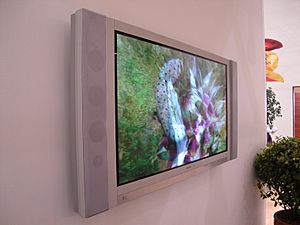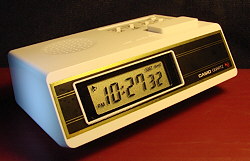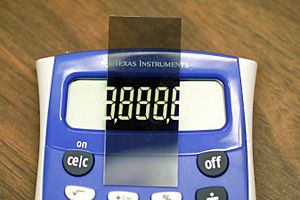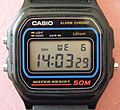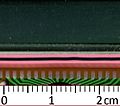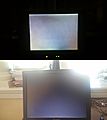Liquid crystal display facts for kids
A liquid crystal display, or LCD, is a flat screen that shows images. Unlike an LED screen, an LCD doesn't make its own light. Instead, it uses special materials to control light passing through it.
LCDs are made of tiny blocks called pixels. Each pixel has liquid crystals inside. These crystals can be made clear or dark by changing the electricity that goes to them. This allows the screen to show different pictures and text.
You can find LCDs in many everyday devices. They are often used in battery-powered gadgets like digital watches because they use very little electricity. They are also common in flat-screen TVs, smartphones, and computer monitors. Many LCDs need a light behind them, called a backlight, to help you see the screen clearly, especially in dark rooms.
How LCD Screens Work
LCDs use a cool trick called electro-optical modulation. This means they use electricity to control how much light gets through. Imagine each tiny pixel on your screen as a tiny window.
Each pixel has a thin layer of liquid crystals sandwiched between two special filters. These filters are called polarizing filters. Think of them like tiny grates. A polarizing filter only lets light pass through if it's lined up in a certain direction.
The two filters in an LCD pixel are placed so their "grates" are perpendicular to each other. This means if no liquid crystals were there, almost no light would get through! It's like trying to push a ruler through two narrow slots that are at right angles to each other – it just won't fit.
Twisting Light with Crystals
Now, here's where the liquid crystals come in. When there's no electricity, the liquid crystals in a pixel naturally "twist" the light as it passes through. This twisting changes the light's direction, allowing it to pass through both filters. When light gets through, that pixel looks clear or bright.
But when a small electric current is sent to the liquid crystals, they untwist. They stop changing the light's direction. Because the light is no longer twisted, it gets blocked by the second filter. When the light is blocked, that pixel looks dark.
By quickly turning the electricity on and off for millions of these tiny pixels, an LCD screen can create all the pictures and videos you see!
Images for kids
See also
 In Spanish: Pantalla de cristal líquido para niños
In Spanish: Pantalla de cristal líquido para niños


